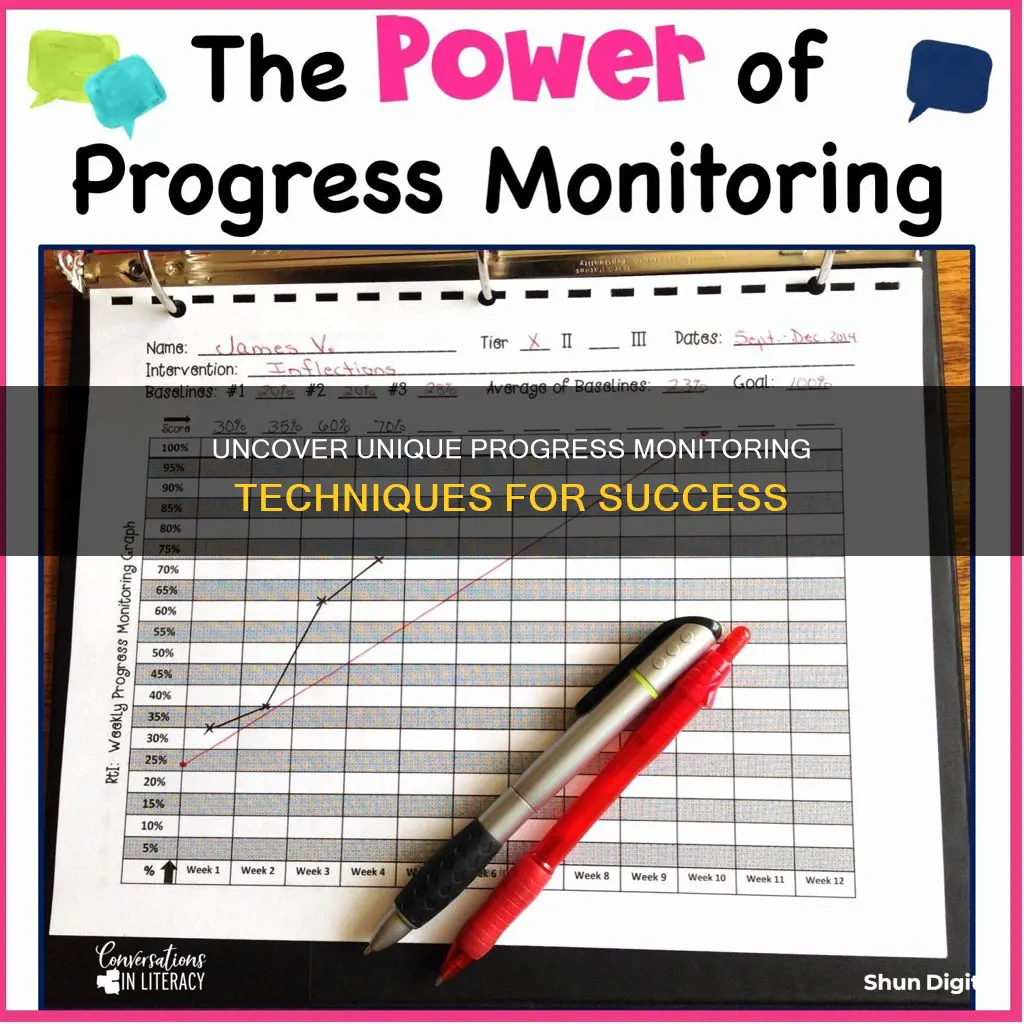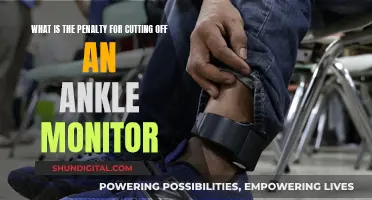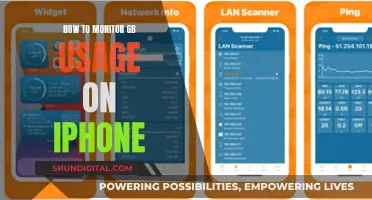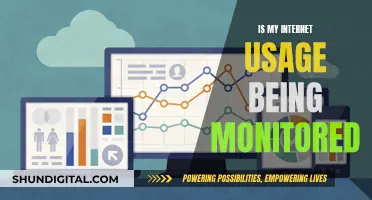
Progress monitoring is a critical component of effective project management and education. It involves creating project plans, setting goals, and periodically evaluating outcomes to determine a project's or student's progress. In the context of special education, progress monitoring is a dynamic approach that empowers educators to adapt their teaching methods to meet the unique needs of each student. By collecting and analyzing data, teachers can make informed decisions, ensure no child is left behind, and enhance their overall quality of life. Progress monitoring tools offer insights into student learning trends, enabling teachers to identify areas where interventions are necessary and adjust their teaching strategies accordingly.
What You'll Learn

Progress monitoring tools for teachers
Progress monitoring is an essential tool for teachers to assess and enhance their students' academic performance and behavioural changes. It is a dynamic process that involves data collection and analysis, allowing teachers to adapt their teaching methods to meet each student's unique learning needs. Here are some progress-monitoring tools that teachers can use to support their students' educational journey:
Unique Learning System
The Unique Learning System is a progress-monitoring platform that offers a comprehensive suite of features for teachers and administrators. It enables teachers to make real-time adjustments to their instruction based on student performance. With access to student data, teachers can easily personalise instruction and quickly address any challenges. The system also facilitates communication between teachers and families, strengthening the school-to-home connection. Additionally, it provides administrator accounts, offering a high-level view of progress for every teacher and student, enabling efficient resource allocation and support.
Academic Progress Monitoring Tools Chart
The National Center on Intensive Intervention has developed an Academic Progress Monitoring Tools Chart, which comprises evidence-based progress-monitoring tools. This chart assists educators and families in selecting tools that address their specific needs. The chart includes ratings on the technical rigor of performance level standards, such as reliability and validity, and growth standards, including sensitivity, alternate forms, and decision rules. It also provides information on bias analysis and key usability features. This comprehensive chart empowers educators and families to make informed decisions about progress-monitoring tools.
Student Progress Monitoring Tool for Data Collection and Graphing (Excel)
The National Center on Intensive Intervention also offers an Excel-based tool designed to support educators in collecting and analysing student progress data. This tool enables educators to store data for multiple students across various measures, graph student progress visually, and set individualised goals. By utilising this tool, teachers can efficiently manage and interpret student data, making data-driven decisions to enhance their instructional approaches.
Curriculum-Based Measurements (CBMs) and Direct Behaviour Ratings (DBRs)
Curriculum-Based Measurements (CBMs) and Direct Behaviour Ratings (DBRs) are valuable tools for teachers to monitor student progress in specific areas. CBMs can be used to assess reading skills, math abilities, and written expression, ensuring that instruction is tailored to meet individual needs. On the other hand, DBRs focus on social behaviour, providing insights into students' behavioural changes and adaptations. By utilising these tools, teachers can gather crucial data and make informed decisions to improve their teaching methods.
Adjusting Monitor Size with DisplayFusion: A Simple Guide
You may want to see also

Student progress tracking
Student-Centred Tracking
Student-centred tracking systems require more instructional time but offer more student investment as students are driving the tracking and making their own connections. These systems usually centre around some sort of individual goal setting, and chart that progress using various forms of student-friendly organisers such as big idea/objective inventories, unit-by-unit graphs, or objective-by-objective charts.
Teacher-Centred Tracking
Teacher-centred tracking systems are controlled and updated by the teacher, who then conveys the messages and trends to their students. This type of tracking is generally more isolated from the rest of the classroom structures and is driven by the teacher, so it may not thrive as much on student investment. However, it should not only be in the form of a personal spreadsheet or other systems, but also visual, class-by-class or student-by-student trackers displayed in the classroom and on hall walls.
How to Track Student Progress
Regardless of the type of tracking system, there are several ways to track student progress:
- Use Google Forms and Sheets: Students can use Google Forms to answer questions about their content understanding, such as "Where am I?", "Where am I going?" and "How do I get there?". They can also use Google Sheets to track their learning and quickly see where they are in relation to their learning targets for a unit.
- Pre-assessments: Pre-assessments allow teachers to find out what students already know and what they still need to be taught before a unit or lesson. This saves time by avoiding covering material that students are already familiar with.
- Whiteboard practice: Students can respond to questions using their whiteboards, allowing teachers to quickly scan the room to see who understands the concept and who doesn't.
- Exit tickets: Short exit tickets with only a few questions can be used to assess what students know after a lesson. They can be quickly graded and sorted to identify which students understand the material and which ones need re-teaching.
- Peer tutoring: Students can be partnered up to learn and practice the material during lessons, taking turns as tutor and tutee.
Unique Progress Monitoring
Unique progress monitoring tools, such as the Unique Learning System, can also be used to support student progress tracking. This system enables teachers to make just-in-time adjustments to instruction based on student performance in lessons and assessments, boosting outcomes. It also allows administrators to have a high-level view of the progress of each teacher and student, enabling them to deliver timely and efficient resources, training, and support to optimise their program.
Is Your Monitor VESA-Compatible? A Quick Guide
You may want to see also

Data-based individualization
DBI is a solution for students with severe and persistent learning difficulties, offering a systematic approach for providing intensive intervention. It uses data to determine how and when students need additional support or intervention and is typically content-specific. It is an ongoing process of making and evaluating instructional adaptations, such as smaller group sizes or increased instructional time.
DBI works well within a multi-tiered approach, and it should be implemented at the most intensive and individualized level of support within these systems. It consists of five steps:
- Validated Intervention Program: Intensify the secondary intervention through quantitative changes to the instruction.
- Progress Monitoring: Evaluate the student’s response to the intensified intervention by collecting progress monitoring data.
- Diagnostic Assessment: Collect and review data to identify areas of difficulty and make informed decisions about adaptations.
- Intervention Adaptation: Adapt the intervention based on the student’s needs as determined by the diagnostic assessment.
- Progress Monitoring: Continue to collect progress monitoring data to evaluate the student’s response to the instructional adaptations.
These steps may need to be repeated multiple times to reach the required levels of intensity and individualization for students to make adequate progress.
Identify Your Monitor Model: A Quick Guide to Knowing Your Screen
You may want to see also

Progress monitoring in special education
The process involves collecting and analysing data, and making informed decisions about instruction. Teachers can use various tools, such as curriculum-based measurements (CBMs) or Direct Behaviour Ratings (DBRs), to monitor reading skills, math abilities, written expression, and social behaviour. This data is then plotted on a graph to visually represent a student's academic journey, making it easier for teachers to adjust their teaching strategies as needed.
It is important to establish learning goals that are realistic, measurable, and aligned with both school-based standards and individual potential. These goals provide a roadmap for both teachers and students, outlining the anticipated academic and behavioural progression. Regular assessments are crucial for effective progress monitoring, and they should be conducted at consistent intervals to track performance and facilitate timely adjustments.
Administrators and teachers can also use progress monitoring to ensure compliance and keep families updated on their child's progress, strengthening the school-to-home connection.
Overall, progress monitoring in special education is a dynamic and ongoing process that adapts to the student's progress, ensuring that no child is left behind. It is a crucial tool that enhances academic outcomes and nurtures important life skills, ultimately improving the quality of life for students.
Finding the Right Monitor: A Comprehensive Guide
You may want to see also

Progress monitoring for project management
Progress monitoring is an essential aspect of project management, ensuring that projects stay on schedule and meet important deadlines. It involves creating project plans, setting goals, and periodically analysing results to determine the project's progress. Here are some detailed steps and strategies for effective progress monitoring in project management:
Plan the Project
The first step in monitoring a project's progress is to create a comprehensive plan. Collaborate with your team members to outline the project's scope, resources, tasks, deadlines, and milestones. Include the project's objectives and key performance indicators (KPIs) that will be used to measure progress. Utilise project planning software or templates, such as Gantt charts, to create a visual representation of the project timeline and task dependencies.
Set Clear Goals and Milestones
Set clear and tailored goals for each team member, ensuring they understand their individual responsibilities and how they contribute to the overall project. Use the SMART method (Specific, Measurable, Achievable, Relevant, Time-based) to create detailed and quantifiable goals. Establish milestones that indicate the beginning and end of major project phases, providing a structured schedule for progress measurement.
Regular Check-Ins and Data Analysis
Create a steady schedule for regular progress check-ins with your team. The frequency of check-ins may vary depending on the project duration; short-term projects may require multiple check-ins per week, while long-term projects may only need monthly check-ins. During these check-ins, compare the team's progress to the key performance indicators and record relevant data. Analyse this data to gauge the overall project progress and identify areas that need improvement.
Adapt and Adjust
Based on your progress monitoring, be prepared to adjust your project plan and goals. If your team is struggling to meet deadlines, consider extending them or providing additional support. On the other hand, if the team is ahead of schedule, you may be able to move up deadlines and complete the project sooner. Progress monitoring should be an ongoing process, allowing for flexibility and adaptability as the project evolves.
Effective Communication
Regular check-ins also provide an opportunity to communicate with your team, build trust, and address any challenges they may be facing. Effective communication is key to ensuring a smooth project flow and helping team members stay motivated and engaged. It is also essential for maintaining clear and consistent communication with stakeholders, keeping them informed about the project's progress and addressing any concerns.
Monitor Risks, Issues, and Assumptions
As a project manager, it is crucial to monitor risks, issues, and assumptions throughout the project. Stay vigilant for potential scope creep and manage client requests that may impact the project's timeline or budget. Challenge requests that deviate from the original scope and consider their impact on the critical path and available resources. Collaborate with a change board to discuss and evaluate proposed changes before taking action.
Track Costs and Budget
Project managers must also monitor the financial aspects of the project. Keep track of additional costs and ensure they do not exceed the allocated budget. Understand the concept of contingency and management reserves, which are money reserves set aside to manage unexpected expenses. Regularly evaluate the financial impact of the project and update the initial business case if necessary.
Utilise Project Management Tools
Take advantage of project management software and tools to facilitate progress monitoring. For example, project dashboards can automatically collect and visualise project metrics, providing real-time updates on the project's progress. These tools enhance collaboration, enable efficient tracking of task dependencies, and help identify potential bottlenecks or delays.
The Monitor Everyone is Buying: Why?
You may want to see also
Frequently asked questions
Unique progress monitoring is a method used by teachers to track a student's academic performance and behavioural changes over time. It involves collecting data and making informed decisions about instruction to improve outcomes and meet each student's unique learning needs.
Unique progress monitoring involves understanding a student's current academic and behavioural level. Teachers then design individualised teaching strategies suited to the student's unique needs. This is an ongoing process that involves frequent assessments and adaptations to teaching methods.
Unique progress monitoring helps to improve a student's academic outcomes and enhances important life skills like problem-solving and resilience. It also provides teachers with concrete evidence of the effectiveness of their teaching methods and allows them to make adjustments as needed.







